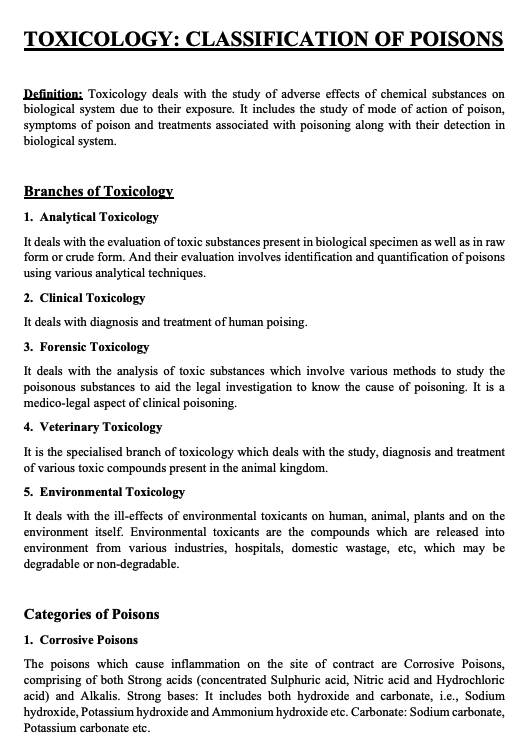Toxicology on Classification of Poisons
Summary:
The “Toxicology on Classification of Poisons” document delves into toxicology, exploring adverse chemical effects on biological systems, with branches including analytical, clinical, forensic, veterinary, and environmental toxicology. It categorizes poisons into corrosive, irritant, neurotic, cardiac, and asphyxiate groups, each affecting the body differently, causing inflammation, irritation, or the nervous or cardiac systems. Corrosive poisons include strong acids and alkalis; irritants comprise inorganic (like lead and arsenic), organic (such as snake venom and toxic plants), and mechanical (like powdered glass) substances. Neurotic poisons impact the central nervous system, including cerebral (alcohol, barbiturates), spinal (strychnine), and peripheral poisons. Cardiac poisons like digitalis and tobacco affect the heart, while asphyxiates like carbon dioxide cause asphyxia in tissues.
Excerpt:
Toxicology on Classification of Poisons
TOXICOLOGY: CLASSIFICATION OF POISONS
Definition: Toxicology deals with the study of adverse effects of chemical substances on
biological system due to their exposure. It includes the study of the mode of action of poison,
symptoms of poison and treatments associated with poisoning, along with their detection in
biological system.
Branches of Toxicology
1. Analytical Toxicology
It deals with evaluating toxic substances present in biological specimens as well as in raw or crude form. Their evaluation involves the identification and quantification of poisons using various analytical techniques.
2. Clinical Toxicology
It deals with the diagnosis and treatment of human poising.
3. Forensic Toxicology
It deals with analysing toxic substances, which involves various methods of studying the poisonous substances to aid the legal investigation in knowing the cause of poisoning. It is a medico-legal aspect of clinical poisoning.
4. Veterinary Toxicology
The specialised branch of toxicology deals with the study, diagnosis and treatment of various toxic compounds present in the animal kingdom.
5. Environmental Toxicology
It deals with the ill effects of environmental toxicants on humans, animals, plants and the environment. Environmental toxicants are compounds released into the environment from various industries, hospitals, domestic waste, etc, which may be degradable or non-degradable.


Reviews